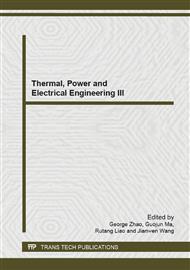[1]
Dan. Wang, Zhen-hui. Wu, Gang. Xu, Da-da. Wang, Meng. Song, Xiao-tao. Peng: Real-time power control of superconducting magnetic energy storage, in IEEE International Conference on Power System Technology, 2012, pp.1-5.
DOI: 10.1109/powercon.2012.6401307
Google Scholar
[2]
H. Komurcugil: Steady-state analysis and passivity-based control of single-phase PWM current-source inverters, IEEE Trans. Ind. Electron., vol. 57, no. 3, p.1026–1030, Mar. (2010).
DOI: 10.1109/tie.2009.2025297
Google Scholar
[3]
Zhihong Bai, HaoMa, Dewei (David) Xu and Bin Wu: Control Strategy With a Generalized DC Current Balancing Method for Multimodule Current-Source Converter, IEEE Transactions on Power Electronics, vol 29, no 1, pp.366-373, (2014).
DOI: 10.1109/tpel.2013.2252628
Google Scholar
[4]
J. Dai, D. Xu, B. Wu, and N. R. Zargari: Unified DC-link current control for low-voltage ride-through in current-source-converter-based wind energy conversion systems, IEEE Trans. Power Electron, vol 26, no 1, pp.288-297, Jan. (2011).
DOI: 10.1109/tpel.2010.2059377
Google Scholar
[5]
Popat Miteshkumar, Wu Bin, Zargari Navid R: Fault ride-through capability of cascaded current-source converter-based offshore wind farm, IEEE Transactions on Sustainable Energy, vol 4, no 2, pp.314-323, (2013).
DOI: 10.1109/tste.2012.2223246
Google Scholar
[6]
Jingya Dai, Sang Woo Nam, Manish Pande, Ghodrat Esmaeili: Medium Voltage Current Source Converter Drives for Marine Propulsion System using a Dual-Winding Synchronous Machine, 2013 IEEE Energy Conversion Congress and Exposition, ECCE 2013, pp.7-12, (2013).
DOI: 10.1109/ecce.2013.6646674
Google Scholar
[7]
Jing Bai, Shi Qi Lu, Jian Liu: Study and Application of Sliding Mode Control Strategy for High-power Current Source Inverter, Applied Mechanics and Materials, vol 527, no 1, pp.259-266, Feb. (2014).
DOI: 10.4028/www.scientific.net/amm.527.259
Google Scholar
[8]
Haixian. Yu: Study of current source high-voltage converter using IGCT, MA thesis, HeFei University of Technology, 2010, pp.31-40.
Google Scholar
[9]
Changyong. Wang, Mao. Liu, Zhongchao. Zhang: Research on phase-shifted SPWM technique in current-source multi-converter, power electronic technology, 1999(4): 43~45.
Google Scholar
[10]
Zhaokai. Yuan: Study on PWM control method of three-phase current source inverter, MA thesis, China University of Petroleum (East China), 2008, pp.11-13.
Google Scholar
[11]
Yu. Xiong, Danjiang. Chen, Changsheng. Hu, Zhongchao. Zhang: Analysis and experi ment of carrier phase-shifted SPWM technique based on current-source multi-converter, power electronic technology, 2003, 37(4): 39~41.
DOI: 10.1109/apec.2003.1179181
Google Scholar


